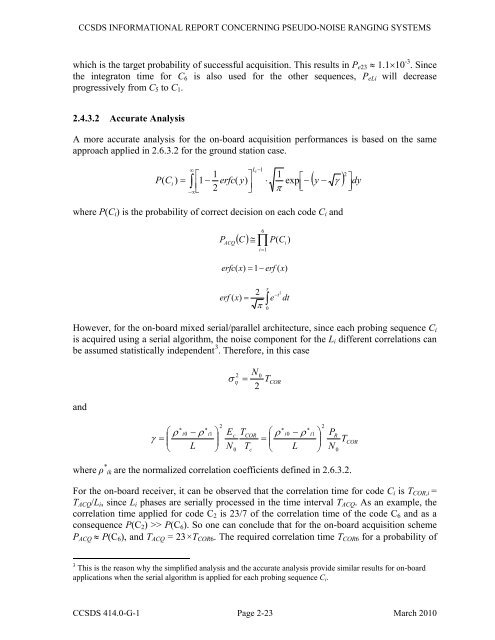Pseudo-Noise (PN) Ranging Systems - CCSDS
Pseudo-Noise (PN) Ranging Systems - CCSDS
Pseudo-Noise (PN) Ranging Systems - CCSDS
Create successful ePaper yourself
Turn your PDF publications into a flip-book with our unique Google optimized e-Paper software.
<strong>CCSDS</strong> INFORMATIONAL REPORT CONCERNING PSEUDO-NOISE RANGING SYSTEMS<br />
which is the target probability of successful acquisition. This results in Pe23 ≈ 1.1×10 -3 . Since<br />
the integraton time for C6 is also used for the other sequences, PeLi will decrease<br />
progressively from C5 to C1.<br />
2.4.3.2 Accurate Analysis<br />
A more accurate analysis for the on-board acquisition performances is based on the same<br />
approach applied in 2.6.3.2 for the ground station case.<br />
∞<br />
−∞<br />
Li<br />
−1<br />
( y )<br />
⎡ 1 ⎤ 1<br />
2<br />
P(<br />
C<br />
⎡ ⎤<br />
i ) = ∫ ⎢<br />
1 − erfc(<br />
y)<br />
⎥<br />
⋅ exp − − dy<br />
⎣ 2 ⎦ ⎢⎣<br />
γ<br />
π<br />
⎥⎦<br />
where P(Ci) is the probability of correct decision on each code Ci and<br />
P<br />
ACQ<br />
6<br />
≅∏ i=<br />
1<br />
( C)<br />
P(<br />
C )<br />
erfc( x)<br />
= 1−<br />
erf ( x)<br />
erf ( x)<br />
=<br />
t<br />
∫e dt<br />
− 2<br />
2<br />
π<br />
However, for the on-board mixed serial/parallel architecture, since each probing sequence Ci<br />
is acquired using a serial algorithm, the noise component for the Li different correlations can<br />
be assumed statistically independent 3 . Therefore, in this case<br />
and<br />
⎛ ρ −<br />
γ = ⎜<br />
⎝<br />
2<br />
σ η =<br />
N<br />
2<br />
<strong>CCSDS</strong> 414.0-G-1 Page 2-23 March 2010<br />
0<br />
x<br />
0<br />
TCOR<br />
∗ ∗<br />
2<br />
∗ ∗<br />
2<br />
i0<br />
ρ i1<br />
⎞ Ec<br />
TCOR<br />
⎛ ρ i0<br />
− ρ i1<br />
⎞ PR<br />
L ⎟ =<br />
N 0 T ⎜<br />
c L ⎟<br />
N 0<br />
where ρ * ik are the normalized correlation coefficients defined in 2.6.3.2.<br />
⎠<br />
For the on-board receiver, it can be observed that the correlation time for code Ci is TCOR,i =<br />
TACQ/Li, since Li phases are serially processed in the time interval TACQ. As an example, the<br />
correlation time applied for code C2 is 23/7 of the correlation time of the code C6 and as a<br />
consequence P(C2) >> P(C6). So one can conclude that for the on-board acquisition scheme<br />
PACQ ≈ P(C6), and TACQ = 23×TCOR6. The required correlation time TCOR6 for a probability of<br />
3 This is the reason why the simplified analysis and the accurate analysis provide similar results for on-board<br />
applications when the serial algorithm is applied for each probing sequence Ci.<br />
⎝<br />
i<br />
⎠<br />
T<br />
COR

















